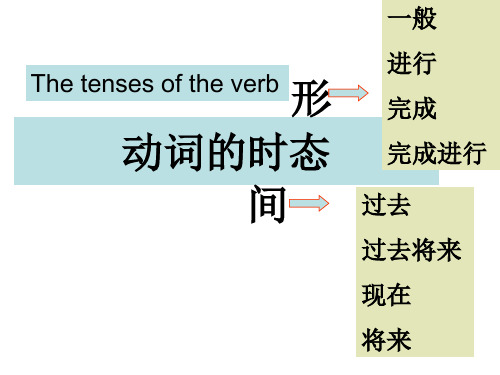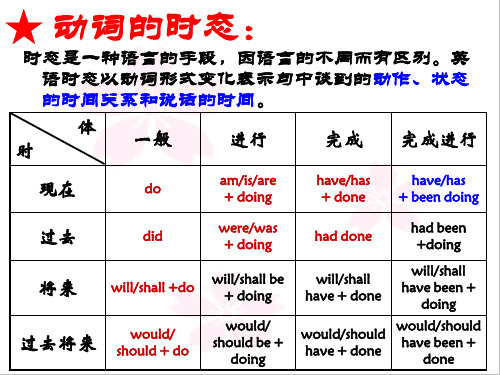动词的时态和语态 ppt课件
合集下载
语法复习-谓语动词的时态+语态(共83张PPT)

现在 过去 将来
一般
进行时
完成时
一般现在时: 现在进行时:
原形(do)
am/is/are doing
第三人称单数形
式(does)
现在完成时: have / has done
一般过去时:
一般过去式 (did)
过去进行时: 过去完成时: was / were doing had done
一般将来时:
1)will do
drop, fit, nod, dig, forget, regret, rid】 • 4)以 y 结尾的动词,直接加 ing • 5)以ie结尾的动词,把ie改为y ,再加ing
动词的ing形式
• run_____ • swim____ • sit ____
• stop_____ • have_____ • dance_____ • organize____
②③不适合语法填空中填 动词的适当形式。
一般将来时的用法
1. He will graduate from Harvard University next year.
2. I am going to buy a new laptop this winter. 3. The car is going to turn over. 5. I am to take over the job. 6. The conference is about to begin.
过去 将来
现在
将来
现在 过去 将来
一般
进行时
完成时
一般现在时: 现在进行时:
原形(do)
am/is/are doing
第三人称单数形
式(does)
【高三一轮复习语法】动词的时态与语态(共28张ppt)

②在条件状语从句和时间状语从句中用一般现在时表将来(主将从现)。 If you leave tomorrow , I'll see you at the airport. 如果你明天走,我到机场送你。 When she comes, I'll tell her about it. 她来时我将把这件事告诉她。 (2)现在进行时表将来 现在进行时表示将来,往往是指计划好或准备要做的事。一些表示动作 转换的动词,如go, come, leave, start, begin,stay,take off,arrive等,或 者也称为位移性动词,其进行时表示马上要做某事。
• He used to get up early . 过去他总是早起。(现在不这样了) • He will be used to getting up early . 他将会习惯早起。 • Wood is used to make paper. 木材被用来造纸。
(三)一般将来时
1、表示将要发生的动作或存在的状态,常用的时间状语有later(on), soon, in a month, next time, from now on, tomorrow等。 I shall be eighteen years old next year. 明年我就十八岁了。 2、一般将来时的其它表示形式 (1)一般现在时表将来 ①按照计划或时刻表要发生的事情。 The new library opens next month. 新图书馆下月开放。 The plane takes off at 3:00 P.m. 飞机于下午三点起飞。
We are about to discuss this problem.我们将马上讨论这个问题。 They were about to leave when the telephone rang. 他们正要离开时电 话响了。
高中英语动词的时态、语态 课件

按词义和句中的作用,动词可以分为四类
类别
特点
意义
vt.及物+宾语 实义动词
须跟宾语一起才能表达 完整的意思
(vt. vi.) 不及物vi.不能直接+ 能独立作谓语 宾语
系动词 跟表语,(有词汇 不能独立做谓语,跟表 (link-v) 意义/状态,持续, 语构成完整意思
表象,感官,变化)
举例 I have a book..
(2)动词第三人称单数形式的变化规则:
构成
例词
一般在动词原形后加s run→runs like→likes
teach→teaches
以ch, sh, s, o, x结尾的动 wash→washes
词,加es
go→goes
pass→passes
以辅音字母加y结尾的动 study→studies 词,先将y变i再加es try→tries
动词的时态、语态
.(1)基本用法: ①表示经常性、习惯性的动作或存在的状态;常与表示 频度的时间状语 always,often,usually,sometimes, once a week,every day 等连用。 He always helps others. 他总是帮助别人。 练习:1,他天天洗头(wash his hair)。
finish 结束
fix 修理/固定
go 去
teach 教
wash洗
have有
say说
play玩
cry 哭
match适应/使相配 guess猜
study学习
carry运送/支撑
主语
第一人称:我、我们
第二人称:你、你们 第三人称:其他的一切
单数 复数
初中英语动词的时态和被动语态(共14张PPT)

延续性动词 be on be at/in+地点 be at/in+地点 be in/a member of be on have know keep
have a cold
have been to—have gone to
曾经去过(主语人在) 已经去了(主语人不在)
--I can’t find you these days.Where have you been?
be over be up be back be away (from) be here /there
非延续性动词 put on come/go to arrive/reach/get to join begin/start buy get to know borrow / lend
catch a cold
定义 表示过去某时间或某动作以前发生的动作。
结构 关健字
S+had+V过去分词
IwSr+heheaanlidzIner’det+aIVchh过ae去dd分let词hftemcoyupHnutar.sde+Sa+t Vh过om去分e词
by the time I came back,by the end of last term, when I got to the station,before he went to bed
表示过去某时刻或某阶段正在发生的动作。
was
1.SW+hawtawsna’st /hwe edroein’gt dwohinegn the UFO arrived?
结构 S+ weredoing 2W. Tahse/yWweerree+hSav+idnoginfugn…th?ese days.
动词PPT课件

被动语态的构成
be动词+动词的过去分词 。例如:The book was written by him.(这本书 是他写的。)
03
动词不定式与动名词
不定式概念及形式
概念
不定式是动词的一种非谓语形式,表 示一种未完成的或将来的动作,由 “to + 动词原形”构成。
形式
不定式有一般式(to do)、完成式( to have done)和进行式(to be doing)三种形式,分别表示不同的 时间概念。
情态动词没有人称和数的变化 ,但有些情态动词有过去式的 变化。
can/could, may/might, must等情态动词用法
can/could 表示能力、可能性、允许或请求。例如
I can swim.(我会游泳。)Could you help me?(你能帮我吗?)
may/might 表示允许、可能或祝愿。例如
虚拟语气是一种特殊的动词形式,用来表示说话人的主观愿望、假设或建议等,而不是客观 事实。
虚拟语气的基本形式包括与现在事实相反的虚拟、与过去事实相反的虚拟和与将来事实相反 的虚拟。
虚拟语气的形式包括基本形式和倒装形式,其中倒装形式用于省略if的条件句中。例如:If I were you, I would go.(如果我是你,我会去的。)Had you come yesterday, you would have seen him.(如果你昨天来的话,你就会见到他了。)
walked to school yesterday.( 她昨天步行去学校。)
将来时
表示将来某个时间将要发生的动 作或存在的状态。例如:They will visit their grandparents next week.(他们下周将去看望
动词的时态和语态-PPT课件

8. The man _h_a_d__h_o_p_e_d__ (hope) to catch the last train, but he was too late.
9. The boys __w_e_r_e_p_l_a_y_in_g___ (play) basketball from 5:00 to 6:00 yesterday.Βιβλιοθήκη .19练习
.
20
用所给动词的正确形式填空: 1. She _l_e_ft__ (leave) the office two
hours ago. 2. As son as she arrived home, the girl
discovered that she _h_a_d__t_a_k_e_n__ (take) her friends book by mistake. 3. Who _c_o_m__e_s__ (come) to school earliest in your class every morning? 4. Great changes _h_a_v_e_t_a_k_e_n_p__la_c_e__ (take place) in this city since 1979. 5. By the time he was twelve, Edison _h_a_d__b_e_g_u_n_ (begin.) to sell newspape21rs.
I’ll go to see you when I have time. I’ll go to see you if I have time tomorrow. 2. 某些动词,如:stand, continue, wish, love, like, hate, feel, find, think等常用一般现在时态
9. The boys __w_e_r_e_p_l_a_y_in_g___ (play) basketball from 5:00 to 6:00 yesterday.Βιβλιοθήκη .19练习
.
20
用所给动词的正确形式填空: 1. She _l_e_ft__ (leave) the office two
hours ago. 2. As son as she arrived home, the girl
discovered that she _h_a_d__t_a_k_e_n__ (take) her friends book by mistake. 3. Who _c_o_m__e_s__ (come) to school earliest in your class every morning? 4. Great changes _h_a_v_e_t_a_k_e_n_p__la_c_e__ (take place) in this city since 1979. 5. By the time he was twelve, Edison _h_a_d__b_e_g_u_n_ (begin.) to sell newspape21rs.
I’ll go to see you when I have time. I’ll go to see you if I have time tomorrow. 2. 某些动词,如:stand, continue, wish, love, like, hate, feel, find, think等常用一般现在时态
中考英语总复习 专题10 动词的时态和语态课件

归纳现在进行时的构成
主语+am/is/are+动词-ing形式
现在进行时的用法
1.表示(biǎoshì)现在(指说话人说话时)正在发生的事情。如: We are waiting for you. 我们正在等你。 2.表示当前一段时间内的活动或现阶段正在进行的动作。如: Mr.Green is writing another novel these days.
A.takes B.took
C.will take D.has taken
第五页,共二十三页。
归纳一般过去时的构成
主语+was/were/did+其他 一般过去时的用法 (1)表示过去某个时间或某一段时间内发生的动作或存在(cúnzài)的状 态。常见的时间状语有:yesterday,last week,an hour ago,the other day,in 1982等。如: Where did you go just now?
您还要些什么吗?
I wondered if you could help me. 我在想你能不能帮我一下。
②情态动词 could,would。如:
Could you lend me your bike? 你的自行车能借我用一下吗?
第七页,共二十三页。
(三)现在(xiànzài)进行时
第八页,共二十三页。
(一)常考的被动语态
A.Invites
C.was invited
B.is invited
D.has invited
第十八页,共二十三页。
2.(2017—2018学年(xuénián)安徽合肥蜀山50中西区第三次月考)If more salt
C to the soup,it will taste better. A.will add B.adds C.is added D.will be added 3.(2018·安徽合肥庐阳区二模,44)All the people I have known in the past three
动词时态语态ppt课件

4) 用在一些句型里:
It is time you went to bed. I wish I were a bird. I'd rather you came tomorrow.
寒假来临,不少的高中毕业生和大学 在校生 都选择 去打工 。准备 过一个 充实而 有意义 的寒假 。但是 ,目前 社会上 寒假招 工的陷 阱很多
(客观安排) I’m going to play football tomorrow afternoon.
(主观安排)
■
现在进行时 寒假来临,不少的高中毕业生和大学在校生都选择去打工。准备过一个充实而有意义的寒假。但是,目前社会上寒假招工的陷阱很多
▲ 现在进行时的基本用法: a. 表示现阶段或目前正进行的动作。 We are waiting for you. Mr. Green is writing another novel this month.
doing
had done
had been +doing
will/shall have + done
will/shall have been +
doing
would/should have + done
would/should have been +
done
一般现在时的用法 寒假来临,不少的高中毕业生和大学在校生都选择去打工。准备过一个充实而有意义的寒假。但是,目前社会上寒假招工的陷阱很多 • 表示经常性或习惯性的动作或存在的状态,常
与表示频度的时间状语连用。 every…, sometimes, often, usually, on Sunday
I leave home for school at 7 every morning. He is alone.
It is time you went to bed. I wish I were a bird. I'd rather you came tomorrow.
寒假来临,不少的高中毕业生和大学 在校生 都选择 去打工 。准备 过一个 充实而 有意义 的寒假 。但是 ,目前 社会上 寒假招 工的陷 阱很多
(客观安排) I’m going to play football tomorrow afternoon.
(主观安排)
■
现在进行时 寒假来临,不少的高中毕业生和大学在校生都选择去打工。准备过一个充实而有意义的寒假。但是,目前社会上寒假招工的陷阱很多
▲ 现在进行时的基本用法: a. 表示现阶段或目前正进行的动作。 We are waiting for you. Mr. Green is writing another novel this month.
doing
had done
had been +doing
will/shall have + done
will/shall have been +
doing
would/should have + done
would/should have been +
done
一般现在时的用法 寒假来临,不少的高中毕业生和大学在校生都选择去打工。准备过一个充实而有意义的寒假。但是,目前社会上寒假招工的陷阱很多 • 表示经常性或习惯性的动作或存在的状态,常
与表示频度的时间状语连用。 every…, sometimes, often, usually, on Sunday
I leave home for school at 7 every morning. He is alone.
中考英语(人教版)动词的时态和语态 (共114张PPT)

考点二 一般过去时 1.概念、句式结构及常用的时间状语 (1)概念:一般过去时表示过去某个时间所发生的动作 或存在的状态。
(2)句式结构(肯定句)有以下四种:
句式结构
例句
was/were+表语 She was a beautiful girl ten years ago. Her father was on business.
句式结构
例句
am/is/are+表语
She is a beautiful girl. Her father is always on business.
there is/are
There is a schoolbag on the desk. There are five people in my family.
(3)常用的时间状语有:yesterday(昨天), the day before yesterday(前天), last week(上星期), last month(上个月), last year(去年), two days ago(两天前), three years ago(三年 前), in 2001(在 2001 年), just now(刚才)等。
(3)描述客观真理、客观存在或科学事实等。 The light travels faster than the sound. 光比声音传播得快。 The sun rises in the east.太阳从东方升起。
注意 在宾语从句中,即使主句是一般过去时,但 从句表示客观真理、客观存在或科学事实时,从句依然用 一般现在时。
(根据汉语意思完成句子。) 如果我找到他的电话号码,我会告诉你。 If I find his phone number, I will tell you.
- 1、下载文档前请自行甄别文档内容的完整性,平台不提供额外的编辑、内容补充、找答案等附加服务。
- 2、"仅部分预览"的文档,不可在线预览部分如存在完整性等问题,可反馈申请退款(可完整预览的文档不适用该条件!)。
- 3、如文档侵犯您的权益,请联系客服反馈,我们会尽快为您处理(人工客服工作时间:9:00-18:30)。
I’ll go to see you when I have time. I’ll go to see you if I have time tomorrow. 2. 某些动词,如:stand, continue, wish, love, like, hate, feel, find, think等常用一般现在时态
Tom goes to work every day. (经常的动作) The machine runs smoothly. (特征) He is very happy. (现在的状态) The earth moves around the sun. (客观真理)
一般现在时态的特殊用法:
1. 在时间和条件状语从句中,用一般现在 时态表示将来的动作。
在时间含义上是“过去的过去”,因此 句子中一般都有一个一个明确的状语或 状与从句来表示过去的时间。
I had studied in Beijing for three years by then. Until then he had known nothing about it. She had only been here for ten minutes when Jim came in.
补充说明:下列动词没有进行时态: 1. 表示状态的动词: seem, look(看起 来),appear, have(有),belong to, own, hold(容纳)
This book belongs to me.
He appears very angry. 2. 表示知道、信念、理解、知识、推测、
2. 表示一种倾向或一种固有特性或经常发 生的动作。 意为“惯于,总是”
When it gets warmer, the snow will start to melt.
He had lived here before he went abroad.
一般将来时(will, shall) 1. 表示将来发生的动作或存在的状态,常 与表示将来的时间状语连用,如 tomorrow, next week, in a few days, next Sunday We will have a dictation tomorrow. He will be back in a few days.
怀疑、希望等含义的动词,如:know,
forget, remember, understand, see,think,believe, hope, doubt 等 I don’t understand why he did it.
I hope I can pass the exam.
一般过去时态: 1. 表示过去某时间发生的事、存在的状态 或过去反复发生的动作。常与表示过去 的时间状语连用,如:yesterday, last week ,during the night
2. 表示目前这段时间正在发生的动作。
He is writing his new novel these days. Those Americans are learning Chinese in Beijing.
现在完成进行时态: have / has been doing 1. 表示发生在过去,一直持续到现在的
几种常见时态的区别: 1 一般现在时态和一般过去时态:
He keeps doing morning exercise to keep fit. He felt cold so he sat closer to the fire. 2 一般过去时态和现在完成时态:
He opened the door. He has opened the door. 3 现在完成时态和过去完成时态: He has lived here since he came here.
动词的时态和语态
英语动词共有16种时态,最基本常用的有:
现在:一般现在时,现在完成时, 现在进行时,现在完成进行时
过去:一般过去时,过去完成时, 过去进行时,(过去完成进行时)
将来:一般将来时,将来完成时, 将来进行时,(将来完成进行时)
一般现在时:
1. 表示经常性、习惯性的动作;表示现在 的状态、特征、能力、客观存在或真 理。句中常用always, often, usually, sometimes, every day 等时间状语
动作,强调动作的连续不停顿。
Tom has been working hard since the new term began. Where have you been living these years?
2. 表示不久前刚结束的动作。 Sorry, I’m late. How long have you been waiting here?
He loves nature. I wish to be back soon.
现在完成时态: 1. 表示从过去某一时间一直延续到现在的
动作或状态,常用延续性的动词。 I have sat hours in the classroom reading a novel. The weather has been cold so far this winter. 2. 表示过去某一动作对现在造成的影响,谓 语动词常为非延续性的动词。
He suddenly fell ill yesterday. He worked in a factory in 2004.
2. 表示过去经常做的动作
When I was in the countryside, I often had a long walk after supper.
过去完成时态:
Have you ever considered moving to the south? I have locked the door.
现在进行时态: 1. 表示此时此刻正在进行的动作。
Are the students dancing? Look, me swans are flying past!
Tom goes to work every day. (经常的动作) The machine runs smoothly. (特征) He is very happy. (现在的状态) The earth moves around the sun. (客观真理)
一般现在时态的特殊用法:
1. 在时间和条件状语从句中,用一般现在 时态表示将来的动作。
在时间含义上是“过去的过去”,因此 句子中一般都有一个一个明确的状语或 状与从句来表示过去的时间。
I had studied in Beijing for three years by then. Until then he had known nothing about it. She had only been here for ten minutes when Jim came in.
补充说明:下列动词没有进行时态: 1. 表示状态的动词: seem, look(看起 来),appear, have(有),belong to, own, hold(容纳)
This book belongs to me.
He appears very angry. 2. 表示知道、信念、理解、知识、推测、
2. 表示一种倾向或一种固有特性或经常发 生的动作。 意为“惯于,总是”
When it gets warmer, the snow will start to melt.
He had lived here before he went abroad.
一般将来时(will, shall) 1. 表示将来发生的动作或存在的状态,常 与表示将来的时间状语连用,如 tomorrow, next week, in a few days, next Sunday We will have a dictation tomorrow. He will be back in a few days.
怀疑、希望等含义的动词,如:know,
forget, remember, understand, see,think,believe, hope, doubt 等 I don’t understand why he did it.
I hope I can pass the exam.
一般过去时态: 1. 表示过去某时间发生的事、存在的状态 或过去反复发生的动作。常与表示过去 的时间状语连用,如:yesterday, last week ,during the night
2. 表示目前这段时间正在发生的动作。
He is writing his new novel these days. Those Americans are learning Chinese in Beijing.
现在完成进行时态: have / has been doing 1. 表示发生在过去,一直持续到现在的
几种常见时态的区别: 1 一般现在时态和一般过去时态:
He keeps doing morning exercise to keep fit. He felt cold so he sat closer to the fire. 2 一般过去时态和现在完成时态:
He opened the door. He has opened the door. 3 现在完成时态和过去完成时态: He has lived here since he came here.
动词的时态和语态
英语动词共有16种时态,最基本常用的有:
现在:一般现在时,现在完成时, 现在进行时,现在完成进行时
过去:一般过去时,过去完成时, 过去进行时,(过去完成进行时)
将来:一般将来时,将来完成时, 将来进行时,(将来完成进行时)
一般现在时:
1. 表示经常性、习惯性的动作;表示现在 的状态、特征、能力、客观存在或真 理。句中常用always, often, usually, sometimes, every day 等时间状语
动作,强调动作的连续不停顿。
Tom has been working hard since the new term began. Where have you been living these years?
2. 表示不久前刚结束的动作。 Sorry, I’m late. How long have you been waiting here?
He loves nature. I wish to be back soon.
现在完成时态: 1. 表示从过去某一时间一直延续到现在的
动作或状态,常用延续性的动词。 I have sat hours in the classroom reading a novel. The weather has been cold so far this winter. 2. 表示过去某一动作对现在造成的影响,谓 语动词常为非延续性的动词。
He suddenly fell ill yesterday. He worked in a factory in 2004.
2. 表示过去经常做的动作
When I was in the countryside, I often had a long walk after supper.
过去完成时态:
Have you ever considered moving to the south? I have locked the door.
现在进行时态: 1. 表示此时此刻正在进行的动作。
Are the students dancing? Look, me swans are flying past!
